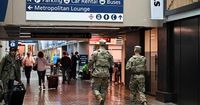On August 27, 2025, the Trump administration took its latest step toward reshaping the nation’s capital, announcing a federal takeover of Washington, D.C.’s iconic Union Station. Transportation Secretary Sean Duffy delivered the news at the bustling hub itself, flanked by Amtrak President Roger Harris and other top officials, marking a dramatic shift in the management of one of America’s busiest and most storied transit centers. The move, which comes amid a broader push by President Donald Trump to assert federal control over the city, has sparked praise, criticism, and plenty of questions about what comes next for the nearly 120-year-old landmark.
Union Station, a grand Beaux-Arts structure sitting just blocks from the Capitol, has long stood as both a gateway to the city and a symbol of its challenges. Opened in 1907, the station has weathered decades of ups and downs—surviving rain damage and closure in the 1980s, a five-year renovation under President Ronald Reagan’s Union Station Redevelopment Act, and, more recently, the devastating impacts of the COVID-19 pandemic. According to the Associated Press, foot traffic plummeted during the pandemic, leaving many shops shuttered and raising new questions about the building’s future.
“He wants Union Station to be beautiful again. He wants transit to be safe again. And he wants our nation’s capital to be great again. And today is part of that,” Duffy declared at the station’s main concourse, echoing the president’s long-standing campaign slogans. The federal government, which owns Union Station, will now assume direct management from Amtrak, the government-owned passenger rail service that has overseen operations since July 2024. The transition, officials say, will occur through a cooperative agreement involving Amtrak and the nonprofit Union Station Redevelopment Corporation, which has long served as the station’s landlord.
Why now? Duffy and other administration officials argue that Union Station has “fallen into disrepair” and is in dire need of a “total transformation.” The station’s challenges are hardly new: issues with cleanliness, safety, and homelessness have plagued the building for years. Crime, too, has become a flashpoint—Vice President JD Vance and other Trump officials publicly criticized the station as “crime-ridden” at an August 20 press conference, and a murder in the parking garage earlier this year only fueled concerns. “By reclaiming station management, we will help make this city safe and beautiful at a fraction of the cost,” Duffy said, as reported by Axios.
To bolster security, National Guard troops have been patrolling the station and its surroundings since Trump’s anti-crime initiative was announced earlier this month. The deployment—part of a wider federal surge of law enforcement and immigration agents across D.C.—has drawn mixed reactions from residents and local leaders. Some see it as necessary to restore order; others, including those who opposed the federal takeover of the Metropolitan Police Department, view it as a heavy-handed assertion of federal authority.
But the administration insists the changes will benefit everyone who uses Union Station. Deputy Transportation Secretary Steve Bradbury outlined a laundry list of needed upgrades—totaling $170 million—including a new roof, new public restrooms, improved elevators, lighting, and security measures. There are also plans for broader enhancements to the passenger experience, and officials have hinted at a possible expansion of the station in the coming years. “We think we can manage the property better, bring in more tenants, bring in more revenue,” Duffy told Reuters, adding that the goal is to attract new shops and restaurants and use the resulting revenue to fund further improvements.
For D.C. Mayor Muriel Bowser, the federal intervention is a welcome relief. The city, she explained at a separate news conference, simply cannot afford the estimated $8 billion or more needed to fully renovate the station. “It has suffered from not being able to get the money that it needs for the renovation,” Bowser said, calling the federal government’s involvement “an amazing initiative.” She added, “It is appropriate for the federal government to make the necessary investments in the transformation of Union Station.”
The management change is not without controversy, though. Some critics see it as yet another example of the Trump administration’s efforts to tighten its grip on the capital. In recent weeks, the president has increased the deployment of federal law enforcement, taken over the city’s police department, and activated thousands of National Guard members. Last week, Trump requested $2 billion from Congress for a sweeping beautification plan for Washington, further fueling debate over the scope of federal power in the district.
The station’s management has shifted before. In 1981, after rainwater poured through the ceiling, the National Park Service declared the building unsafe and closed it for five years. The subsequent restoration, aided by the Reagan-era redevelopment act, gave Union Station a new lease on life. But as the Washington Post and Reuters report, deferred maintenance and shifting priorities have left the building once again in need of major investment. The Biden administration had previously proposed a $10 billion redevelopment plan for Union Station, but that initiative will be scrapped in favor of the Trump administration’s new vision, according to Bradbury.
Amtrak, for its part, has not publicly commented on the latest management shakeup. The rail service had only just taken over direct management of the station last year, after a court ruling granted it that authority in coordination with the Federal Railroad Administration. Last year, Amtrak also launched an initiative to revitalize the station and, on August 28, 2025, debuted its NextGen Acela high-speed trains on the Northeast Corridor. These new trains, capable of reaching speeds up to 160 mph, represent a significant upgrade for the region’s busiest rail route, which sees some 800,000 daily trips and accounts for a fifth of the U.S. economy. Harris, Amtrak’s president, called the launch “a major milestone” for both the company and the traveling public.
The broader context is hard to ignore. The Biden administration had allocated $22 billion over five years to Amtrak for modernization and repairs, a point Democrats have been quick to highlight. At the same time, the Trump administration recently announced cuts to a federal grant for Amtrak, claiming it would save taxpayers $120 million. These competing visions for the nation’s rail infrastructure have only sharpened the debate over how best to restore and maintain Union Station.
Homelessness remains a visible challenge. The station has long served as a refuge for people seeking shelter, and the proliferation of tents in Columbus Circle prompted the National Park Service to clear encampments in June 2022. Federal officials have since promised to address both homelessness and crime as part of the station’s transformation, though advocates warn that simply moving people along does little to address the root causes of poverty and housing insecurity in the city.
As the dust settles on this latest federal intervention, one thing is clear: Union Station’s fate is now firmly in the hands of the Trump administration. Formal action confirming the Department of Transportation’s renewed control is expected in September, and the coming months will reveal whether the promised improvements materialize—and whether the station can once again become the “point of pride” that so many Washingtonians, travelers, and officials hope it will be.
For now, travelers and commuters can expect to see more uniformed personnel, more construction, and, perhaps, a new era for the storied landmark at the heart of the nation’s capital.

